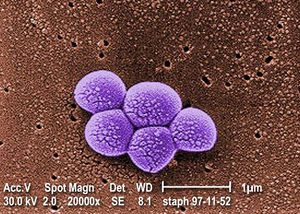Racial Disparities in MRSA Infections
What is MRSA?

By Amir Johnson
Methicillin-Resistant Staphylococcus aureus, or MRSA for short, is a Gram-positive cocci-shaped (spherical) bacterium that measures approximately 1μm in diameter and forms clusters that are popularly described as being grape-like. [1] S. aureus is present on and within the bodies of many individuals asymptomatically, and as a result of this it often remains unnoticed. According to studies around 20% of people are persistent nasal carriers of S. aureus and around 30% are intermittent carriers, with the remaining 50% not carrying the bacterium. [1] Other than within the nose, S. aureus can be commonly seen present on the skin, skin glands, guts, and a variety of mucous membranes. This presence within the body is referred to as colonization, and it significantly increases the chances of acquiring an infection by providing a reservoir of the pathogen. [1] In most cases, the previously asymptomatic, commensal S. aureus that previously colonized the microbiome of individuals is responsible for their infection. [2] Within the world of public health and medicine, a hugely important factor associated with S. aureus is its significant level of acquisition of resistance against multiple antibiotic classes, which greatly complicates efforts to treat it clinically. Cite error: Closing </ref> missing for <ref> tag ]]
Section 4
Include some current research, with at least one figure showing data.
References
- ↑ 1.0 1.1 1.2 Lakhundi, S., & Zhang, K. https://doi.org/10.1128/CMR.00020-18 "Methicillin-Resistant Staphylococcus aureus: Molecular Characterization, Evolution, and Epidemiology." 2018. Clinical microbiology reviews, 31(4), e00020-18.
- ↑ Rhonda Griffiths, Ritin Fernandez, Elizabeth Halcomb "Reservoirs of MRSA in the acute hospital setting: A systematic review" 2002. Contemporary Nurse, 13:1, 38-49
